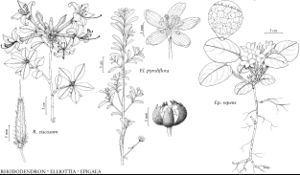Elliottia
Sketch Bot. S. Carolina 1: 448. 1817 ,.
Shrubs or trees. Stems erect; twigs glabrous. Leaves deciduous [persistent], alternate, sometimes seemingly whorled; petiole present; blade subcoriaceous, margins entire. Inflorescences terminal racemes, panicles, or cymes, 2–80-flowered, sometimes flowers solitary; perulae absent. Flowers bisexual, radially symmetric; sepals [3–]5, ± distinct; petals 4–5, distinct or connate to 1/4 their lengths, corolla deciduous, rotate; stamens 8(–10), exserted; anthers without awns, dehiscent laterally; ovary 5–6-locular; style exserted; stigma expanded, discoid. Fruits capsular, spheroidal or oblate-spheroidal, dehiscence ± septicidal. Seeds 30–100, ovoid, flattened, not tailed, sometimes winged; testa pitted. x = 11.
Distribution
se, w North America, e Asia (Japan).
Discussion
Cladothamnus Bongard; Tripetaleia Siebold & Zuccarini
Species 4 (2 in the flora).
Although Cladothamnus, Elliottia, and Tripetaleia were long treated as distinct genera, B. A. Bohm et al. (1978) concluded that they should be merged in a single genus. This was followed by P. F. Stevens et al. (2004). The two species endemic to Japan are E. bracteata Bentham & Hooker f. and E. paniculata Bentham & Hooker f.
Selected References
None.
Lower Taxa
Key
| 1 | Shrubs, 0.5-3 m; inflorescences solitary flowers or cymes; petals pinkish to copper colored. | Elliottia pyroliflora |
| 1 | Shrubs or trees, (2-)3-5(-12) m; inflorescences racemose or paniculate; petals white. | Elliottia racemosa |
